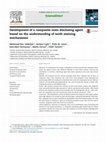Book chapter by Mohamed-Nur Abdallah
http://www.amazon.com/dp/9814463124/ref=cm_sw_r_fa_dp_jVxmtb1X1KM38/190-6101906-4045036
Papers by Mohamed-Nur Abdallah

Calcium phosphate ceramic materials are extensively used for bone replacement and regeneration in... more Calcium phosphate ceramic materials are extensively used for bone replacement and regeneration in orthopedic, dental, and maxillofacial surgical applications. In order for these biomaterials to work effectively it is imperative that they undergo the process of degradation and resorption in vivo. This allows for the space to be created for the new bone tissue to form and infiltrate within the implanted graft material. Several factors affect the biodegradation and resorption of calcium phosphate materials after implantation. Various cell types are involved in the degradation process by phagocytic mechanisms (monocytes/macrophages, fibroblasts, osteoblasts) or via an acidic mechanism to reduce the micro-environmental pH which results in demineralization of the cement matrix and resorption via osteoclasts. These cells exert their degradation effects directly or indirectly through the cytokine growth factor secretion and their sensitivity and response to these biomolecules. This article discusses the mechanisms of calcium phosphate material degradation in vivo.

j o u r n a l o f d e n t i s t r y 4 0 s (2 0 1 2) e 2 5 – e 3 3 a b s t r a c t Objectives: The... more j o u r n a l o f d e n t i s t r y 4 0 s (2 0 1 2) e 2 5 – e 3 3 a b s t r a c t Objectives: The mechanism of tooth bleaching using peroxide oxidizers is not fully understood. It is unknown whether peroxide radicals make teeth whiter by deproteinizing, demineralizing, or oxidizing tooth tissues. This study was designed to define the mechanism of tooth bleaching and determine which of tooth enamel chemical components is/are affected by bleaching. Methods: Sixty sound teeth were collected from adult patients. The teeth were divided into 6 equal groups (n = 10). Groups 1, 2, 3 and 4 were treated for 4 days with one of the following solutions: deproteinizing (NaOH) that removes organic content, demineralizing (EDTA) that decalcifies the mineral content, oxidizing (H 2 O 2) and distilled water (control). Group 5 and 6 were pre-treated with either deproteinizing or demineralizing solutions before treating them with oxidizing solutions for 4 days. Changes in enamel elemental ratios, crystallinity index and tooth shade parameters of the treated teeth were examined by means of EDS, Raman spectroscopy and shade-spectrophotometry. The data obtained was analysed with Wilcoxon Signed-Ranks Test, and the statistical signicance was set at p < 0.05. Results: Tooth deproteinization increased the lightness by 4.8 AE 2.78, tooth demineralization resulted in 8.5 AE 5.68 decrease in the lightness and tooth oxidization induced 19.9 AE 6.58 increase in the lightness. Oxidization of the deproteinized teeth did not influence shade parameters, but oxidation of the demineralized teeth resulted in 10.7 AE 5.88 increase in the lightness. Conclusion: Hydrogen peroxide does not induce significant changes in tooth enamel organic and inorganic relative contents, and it whitens teeth just by oxidizing their organic matrix. These findings are of great clinical significance since they explain the mechanism of tooth bleaching, and help understanding its limitations and disadvantages.

j o u r n a l o f d e n t i s t r y 4 2 (2 0 1 4) 6 9 7 – 7 0 8 a b s t r a c t Objectives: To ch... more j o u r n a l o f d e n t i s t r y 4 2 (2 0 1 4) 6 9 7 – 7 0 8 a b s t r a c t Objectives: To characterize the surface composition of dental enamel and composite resin, assess the ability of dyes with different affinities to stain these surfaces, and use this information to develop a disclosing agent that stains composite resin more than dental enamel. Methods: One hundred and ten sound extracted teeth were collected and 60 discs of composite resin, 9 mm diameter and 3 mm thick, were prepared. X-ray photoelectron spectroscopy (XPS) was employed to determine the elemental composition on the different surfaces. A tooth shade spectrophotometer was used to assess the change in shade after staining the surfaces with different dyes. Results: XPS analysis revealed that surfaces of both outer dental enamel and composite resin contained relatively high amounts of carbon, specifically hydrocarbons. Both dental enamel and composite surfaces were stainable with the hydrophobic dye (p < 0.05); however , the composite resin was stained more than the dental enamel (p < 0.05). Conclusions: The hydrophobic surface of dental enamel and composite resin might explain their high affinity to be stained by food and beverages containing hydrophobic molecules. The composite resin is more stainable by hydrophobic dyes than dental enamel. We used this information to develop an agent for disclosing composite resins that could be used to visualize composite resins that need to be removed. Clinical significance: Removal of composite resin can be problematic, time consuming and stressful to the dental practitioner. A composite disclosing agent would help the dental practitioner identify the composite resin and facilitate its removal without damaging the adjacent healthy tooth tissues.
Harm Reduction Journal, 2010
Background and objectives: Narghile is becoming the favorite form of tobacco use by youth globall... more Background and objectives: Narghile is becoming the favorite form of tobacco use by youth globally. This problem has received more attention in recent years. The aim of this study was to investigate the prevalence and pattern of narghile use among students in three public Jordanian universities; to assess their beliefs about narghile's adverse health consequences; and to evaluate their awareness of oral health and oral hygiene.

Uploads
Book chapter by Mohamed-Nur Abdallah
Papers by Mohamed-Nur Abdallah